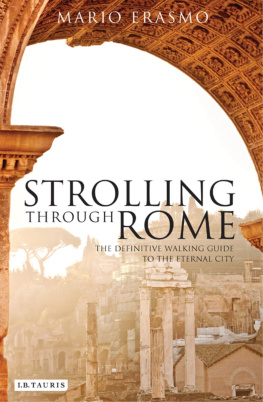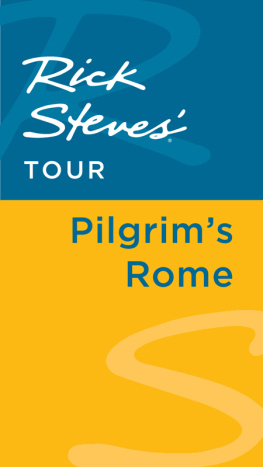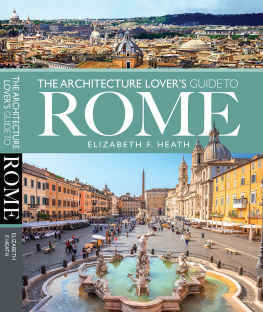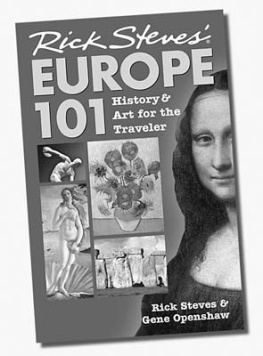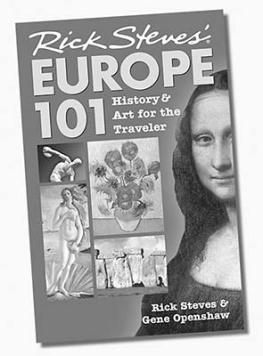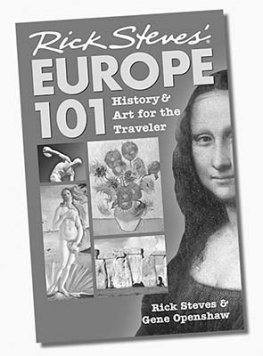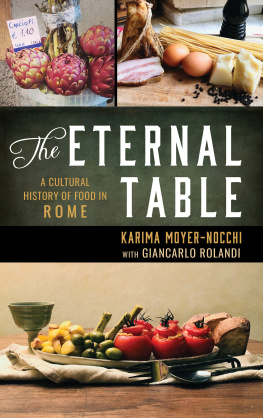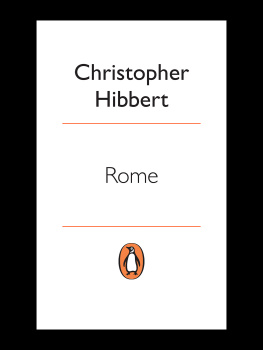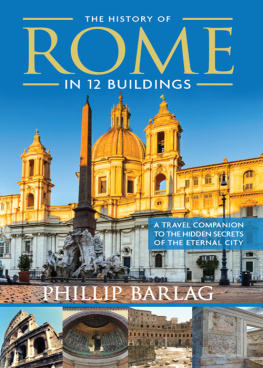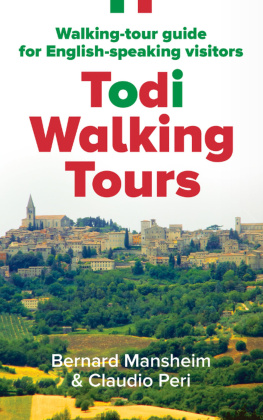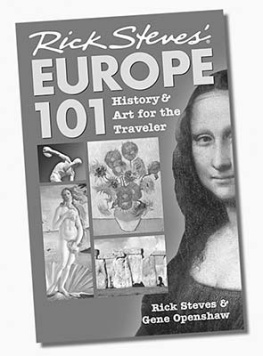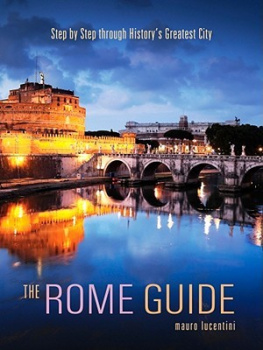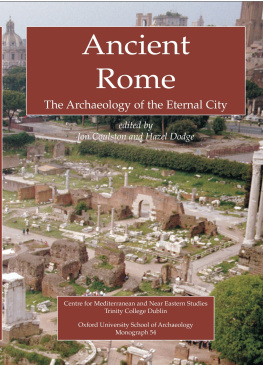
Mario Erasmo is Professor of Classics at the University of Georgia. He is the author of several books on the cultural history of Italy and the legacy of Classical Antiquity including Reading Death in Ancient Rome (2008) and Death: Antiquity and Its Legacy ( I.B.Tauris , 2012), with extensive experience teaching and leading tours throughout Italy, France and the UK.
First published in 2015 by
I.B.Tauris & Co. Ltd
London New York
www.ibtauris.com
Copyright 2015 Mario Erasmo
The right of Mario Erasmo to be identified as the author of this work has been asserted by him in accordance with the Copyright, Designs and Patents Act 1988.
All rights reserved. Except for brief quotations in a review, this book, or any part thereof, may not be reproduced, stored in or introduced into a retrieval system, or transmitted, in any form or by any means, electronic, mechanical, photocopying, recording or otherwise, without the prior written permission of the publisher.
ISBN: 978 1 78076 351 4
eISBN: 978 0 85773 889 9
A full CIP record for this book is available from the British Library
A full CIP record is available from the Library of Congress
Library of Congress Catalog Card Number: available
C ONTENTS
L IST OF I LLUSTRATIONS
Images are photographed and supplied by the author with the exception of the Aurora by Guercino, which is supplied and reproduced by the kind permission of HSH Prince Nicol Boncompagni Ludovisi and HSH Princess Rita Boncompagni Ludovisi.
All maps OpenStreetMap Contributors. Data is available under the Open Database Licence.
A CKNOWLEDGEMENTS
I am honoured by the kind and generous assistance of HSH Prince Nicol Boncompagni Ludovisi and HSH Princess Rita Boncompagni Ludovisi . I am also grateful to Filippo Amisano, T. Corey Brennan, Danielle Carrabino, Penelope Davies, Dora Erasmo, Josh Koons, Christopher P. Robinson and Tim Smalley for research assistance and support. I owe special thanks to Tatiana Wilde and the editorial staff at I.B.Tauris .
P REFACE
Unlock the secrets of the Eternal City through step-by-step walking tours of the historic areas of this beguiling city, from evocative ancient ruins, solemn early Christian and Jewish sites, winding medieval streets, Renaissance palaces and theatrical Baroque architecture in the heart of the vibrant modern city. Itineraries include parks with sweeping vistas and quiet places to enjoy a romantic stroll or al fresco lunch. Go under the city to explore earlier layers: the sources for Romes perennial rebirth.
Romes most recent Imperial past under Fascism restored the antiquities of the city for ideological purposes. That Rome, modern yet rooted in its ancient past, is what still greets visitors today. Ironically, what survives from antiquity survives despite its connection to Imperial Rome as Christian Rome erased its pagan precursor and reused its materials for the construction of its own identity. Monuments once destroyed for building materials are now valued as memorials of Romes glorious past. Roma sparita (Rome disappeared) is gone but it asserts its presence in the urban fabric of the city and in the popular imagination. There is no place like Rome.
Tours are sequential but they may also be taken in any order. The walking distance of tours and times will vary depending on the number of sites visited. Many itineraries include options to visit additional sites requiring a longer stroll or transportation by ATAC, Romes integrated public transportation system (bus, metro and regional train). Just when you feel you have seen too many chapels or paintings, think of them as ancient Roman tombs whose inscriptions call out to passers-by to take note of the deceaseds identity: Yes, you have seen this theme before, but have you seen my version?
Stroll on
I NTRODUCTION
The Eternal City
The Eternal City, enticing yet aloof, has staged more events from the annals of history than any other city. The idiom When in Rome do as the Romans do speaks to the historical power of its sense of self enforced by the censorial brows of the conoscenti . Rome loves a winner and since antiquity the streets have witnessed their triumphs and the humiliation of historys losers. Strolling the streets of Rome is to participate in the theatre of history as spectator and actor.
Ancient Romans traced their ancestry back to the mythological Aeneas , the son of the goddess Venus and the Trojan Anchises. After the Fall of Troy he settles in Italy and establishes the royal line through his son Ascanius (also called Iulus from whom the family of Julius Caesar claimed descent) that leads to Romulus and Remus , the children of the god Mars and Vestal Virgin Rhea Silvia (or Ilia). After vying with his brother, Romulus founds Rome on 21 April 753 BCE . He is deified as the god Quirinus and not until Julius Caesar would another historic figure be deified. The Archaic period of the Kings under whom the village of the Seven Hills is transformed into a city ends with their expulsion and the founding of the Roman Republic in 509 BCE . Against the backdrop of Periclean Athens in mid-5th century BCE , Rome continues to grow and the next century witnessed the highs of defeating their Etruscan rivals to the north in 396 BCE and the lows of being captured by the Celts in 391 BCE . After Philip of Macedon and Alexander the Great took control of the eastern Mediterranean, Rome fought a series of wars in central Italy and against the Carthaginians in North Africa that culminated in the defeat of Hannibal (202 BCE ). Rome controlled the Mediterranean from Spain to North Africa and finally Greece in 146 BCE but it was still governed by the Republican political offices of consuls and tribunes whose powers were checked by censors and aristocratic factions in the Senate.
In the 1st century BCE , the generals Sulla , Marius and Pompey the Great exploited Romes weaknesses in a series of Civil Wars causing the breakdown of the Republic bemoaned by the orator Cicero that culminates with the dictatorship of Julius Caesar . After Caesars assassination on the Ides of March in 44 BCE , his great nephew and adopted heir Octavian, the future emperor Augustus , vies with Mark Antony for sole political control. Following his victory over Antony and Cleopatra at the Battle of Actium in 31 BCE , Augustus establishes a principate that is a veneer for monarchy. Romes first emperor, as the son of the deified Julius Caesar, emulates his mythological ancestor Aeneas in refounding the legendary Golden Age based on peace, the Pax Romana . Augustus founds the first dynasty of Imperial Rome , the Julio-Claudian (Augustus, Tiberius, Gaius Caligula, Claudius and Nero). As Christians form their first communities in Rome in areas of older Jewish communities visited by St Peter and St Paul , pagan worship continues and eastern cults such as the Cult of Mithras are popular empire-wide including the city of Rome.
After a succession of emperors in 69 CE , Vespasian founds the Flavian dynasty, through his sons Titus and Domitian , that monumentalised the city with the Colosseum and Imperial palace on the Palatine Hill, the site of St Sebastian s martyrdom. In the 2nd century CE , Nerva and the Antonines ushered in the era of the Five Good Emperors who adopted their successors (Nerva, Trajan, Hadrian, Antoninus Pius and Marcus Aurelius) that ended with the accession of Marcus Aurelius son Commodus. The instability of the Severan dynasty (Septimius Severus, Caracalla, Geta, Macrinus, Elagabulus, Alexander Severus) in the 3rd century causes anxiety witnessed by the Emperor Aurelians construction of the Aurelianic Walls that expanded the boundaries of the Republican Walls from the 6th to 4th century BCE (also known as the Servian Walls) to withstand Barbarian incursions. After Constantine s victory over his co-ruler Maxentius at the Battle of the Milvian Bridge in 312 CE , the Edict of Milan (313 CE ) gave legal protections to Christians and he founds Christian basilicas on Imperial property at the edges of the city. He called the Council of Nicaea in 325 from which came the Nicene Creed. Constantine moved the capital to Constantinople (Byzantium) and the Empire was ruled by Byzantine emperors in the east. Figurehead emperors control Rome following the Sack of the Visigoths (410) and Vandals (455) and the power of the popes grows under Pope Leo the Great (440461) and Pope Gregory the Great (590604).
Next page
